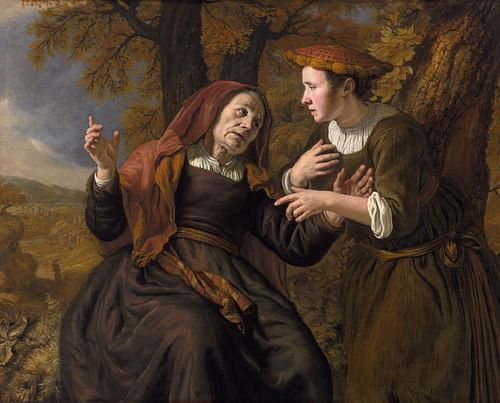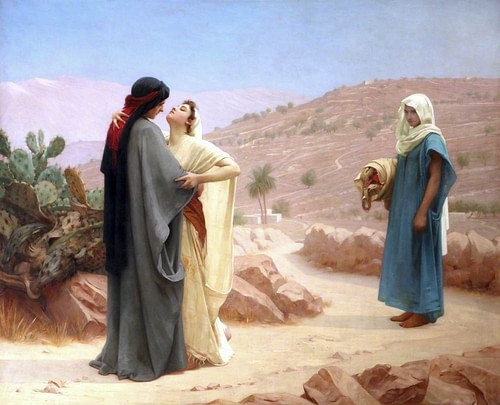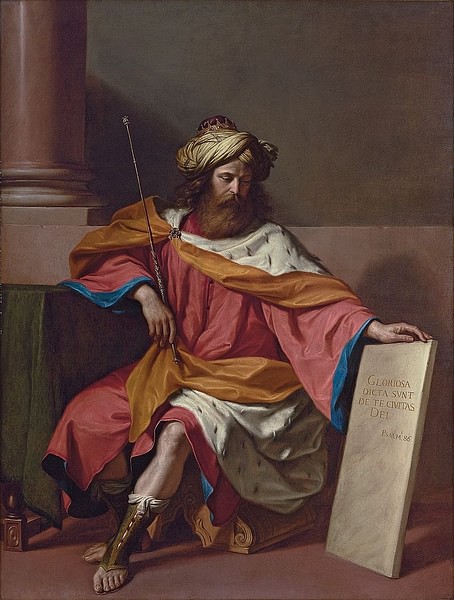Which Town in Israel Is Naomi and Her Family From, and Returned to?
The story of Ruth and Naomi is found in the book of Ruth in the Jewish Scriptures. The Scriptures are traditionally divided into three sections: Torah (the first five books assigned to Moses), the Prophets (Nevi'im), and Writings (Ketuvim, where we discover Ruth). Chronologically, the book falls within the menstruation of the Book of Judges and 1 Samuel, books which chronicle the settlement of the twelve tribes of Israel in the land of Canaan after their escape from Egypt (Exodus). Although placed inside this timeframe, scholars consider the creation of the book in the menses of the 6th-4th centuries BCE.

Ruth Swearing her Fidelity to Naomi
The Story
The story highlights a concept known as Levirate marriage where a dead man'south blood brother or close relative was to marry the widow.
The book of Ruth tells the story of Naomi, a adult female from Bethlehem, who was married to Elimelech, with whom she had two sons, Mahlon and Chilion. The family emigrated to the neighboring territory of Moab (for reasons not stated, merely most likely either famine or work opportunities). While living in Moab, the two sons married local women, Ruth and Orpah. Elimelech then died.
Naomi wanted to return to her home hamlet, where, as a widow, she could rely upon relatives to help keep her. She advised the daughters-in-police force to return to their own families. Oprah did and so. Ruth, however, replied:
Don't urge me to leave you or to turn back from you. Where yous go I will go, and where y'all stay I will stay. Your people will be my people and your God my God. Where y'all dice I will die, and there I will exist buried. May the Lord deal with me, exist it ever so severely, if even death separates y'all and me. (Ruth 1:16-17)
The 2 returned to Bethlehem near the time of the barley harvest. Naomi and Ruth went and "gleaned" in the fields. 'Gleaning' ("to draw") is a concept found in the volume of Leviticus as a means of charity:
When you reap the harvest of your land, do not reap to the very edges of your field or gather the gleanings of your harvest. Practice not become over your vineyard a 2d time or pick up the grapes that have fallen. Leave them for the poor and the greenhorn. I am the Lord your God. (nineteen:9-10)
The field was owned by Boaz, a relative of Naomi's husband Elimelech. Boaz noticed Ruth and made sure plenty grain was left to feed her and Naomi. The story highlights a concept known as Levirate matrimony. For the bloodline not to be broken, a dead homo's brother or close relative was to marry the widow:
If brothers are living together and one of them dies without a son, his widow must not marry outside the family. Her husband's blood brother shall take her and ally her and fulfill the duty of a brother-in-law to her. The get-go son she bears shall behave on the proper name of the dead brother so that his proper name volition non be blotted out from Israel. However, if a man does not desire to ally his brother's wife, she shall go to the elders at the town gate and say, "My husband's blood brother refuses to acquit on his brother's name in Israel. He will not fulfill the duty of a blood brother-in-law to me." And then the elders of his town shall summon him and talk to him. If he persists in saying, "I practice not desire to marry her," his brother's widow shall go up to him in the presence of the elders, take off ane of his sandals, spit in his face and say, "This is what is done to the homo who will not build up his brother's family line." That man'south line shall be known in State of israel as The Family unit of the Unsandaled. (Deuteronomy 25:five-10)

Ruth & Naomi
One day Ruth's mother-in-law Naomi said to her, "My daughter, I must find a dwelling house for you lot, where yous will exist well provided for. At present Boaz, with whose women you lot have worked, is a relative of ours. This night he will exist winnowing barley on the threshing floor. Launder, put on perfume, and get dressed in your all-time dress. Then go downwards to the threshing floor, but don't allow him know y'all are there until he has finished eating and drinking. When he lies down, note the place where he is lying. Then go and uncover his feet and prevarication downward. He will tell you what to practice." "I will do any you say," Ruth answered. (Ruth 3:i-5)
To "uncover the feet" was a biblical euphemism for sexual intercourse. Nonetheless, Boaz informed Ruth that in that location was a closer kinsman. The next morning, he met the kinsman in forepart of the elders at the city gate for a resolution. The kinsman did not want to jeopardize his ain estates, so he conceded to Boaz by taking off his sandal and handing information technology over. The story concludes with the birth of the son of Ruth and Boaz, Obed. We learn that Obed became the father of Jesse, the father of King David.
The Purpose of the Book of Ruth
In the Western tradition, Ruth'due south oral communication to Naomi is often utilized in marriage vows.
In add-on to providing a window on the culture and practices of ancient Israel, the book of Ruth highlights ii Jewish concepts: redemption, and chesed or "loving kindness." Redemption meant existence saved from sin or error. Information technology also included the idea of regaining something in exchange for a debt or ownership. In this case, both Naomi and Ruth were redeemed by Boaz'south actions so that they would survive and generate offspring. Chesed was both the loving kindness of God to Israel besides as the kindness that is to be shared among humans in works of charity. It was also understood as loyalty either to God or persons. Ruth's devotion to her mother-in-constabulary was extended to Naomi'due south God besides.
While placed during the fourth dimension of Judges (c. 1100 BCE), the consensus of scholars has the composition of the book during the time of the return of the Jewish exiles to Jerusalem under the auspices of Cyrus the Keen (r. c. 550-530), the king of the Western farsi Achaemenid Empire (539 BCE). The community was guided by two priestly individuals, Nehemiah and Ezra, who were in charge of the rebuilding of the Temple.
The Prophets of Israel had blamed the disaster of the Babylonian destruction of Jerusalem (586 BCE) on the sins of Israel, particularly the sin of idolatry. The books of Nehemiah and Ezra outline their attempts to make sure that this would never happen once more. Believing that intermarriage with non-Jews would lead to idolatrous practices, they banned intermarriage:
On that day the Book of Moses was read aloud in the hearing of the people and in that location it was found written that no Ammonite or Moabite should always exist admitted into the assembly of God, because they had non met the Israelites with nutrient and water simply had hired Balaam to call a curse downward on them. (Our God, notwithstanding, turned the expletive into a blessing.) When the people heard this law, they excluded from Israel all who were of foreign descent. (Nehemiah 13:1-3)
The book of Ruth may have been written equally a reaction against this ban. It demonstrates that not-Jewish foreigners could become platonic exemplars of Jewish tradition and practices, fifty-fifty the Moabites. Not only were Naomi and Ruth good Jews, simply Ruth became the ancestor of Israel's greatest king, David.

King David Writing Psalms
Modern Interpretations
The story of Naomi and Ruth is ofttimes called upon in scholarly analyses of the study of women in the Old Testament and gender roles in aboriginal Judaism. Feminists continue to contend both sides. Some denounce the story for exploiting the evils of patriarchy as women are only valued for their procreation, while others praise the resourcefulness of Naomi and Ruth to survive. In the Western tradition, Ruth's speech communication to Naomi is oftentimes utilized in union vows.
In Jewish synagogues, the Book of Ruth is read during the vacation of Shavuot. Originally an ancient grain festival that celebrated the early on harvest of some grains in the jump, it occurs seven weeks afterward the second Seder of Passover. By tradition, this was also a celebration of when Moses received the Law on Mount Sinai. This story combines harvesting and obedience to the Law of Moses.
This commodity has been reviewed for accuracy, reliability and adherence to academic standards prior to publication.
Source: https://www.worldhistory.org/article/1845/ruth--naomi/
0 Response to "Which Town in Israel Is Naomi and Her Family From, and Returned to?"
Postar um comentário